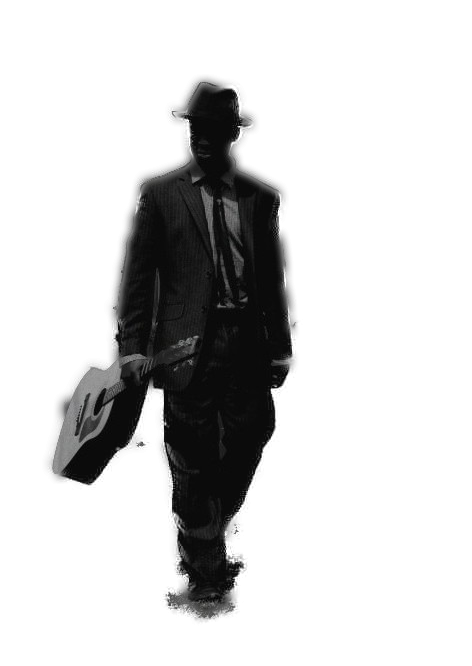
Robert Johnson and the Devils Music


Robert Leroy Johnson (May 8, 1911 – August 16, 1938) was an American Blues musician and songwriter. His landmark recordings in 1936 and 1937 display a combination of singing, guitar skills, and songwriting talent that has influenced later generations of musicians. Although his recording career spanned only seven months, he is recognized as a master of the blues, particularly the Delta blues style, and one of the most influential musicians of the 20th century. The Rock and Roll Hall of Fame describes him as perhaps "the first ever rock star".
As a traveling performer who played mostly on street corners, in Juke joints, and at Saturday night dances, Robert Johnson had little commercial success or public recognition in his lifetime. He participated in only two recording sessions, one in San Antonio in 1936, and one in Dallas in 1937, that produced 29 distinct songs (with 13 surviving alternate takes) recorded by Don Law. These songs, recorded solo in improvised studios, were the totality of his recorded output. Most were released as 10-inch, 78 rpm singles from 1937–1938, with a few released after his death. Other than these recordings, very little was known of him during his life outside of the small musical circuit in the Mississippi Delta where he spent most of his life.
Much of his story has been reconstructed by researchers. Johnson's poorly documented life and death have given rise to much legend. The one most closely associated with him is that he sold his soul to the devil at a local crossroads to achieve musical success.
His music had a small, but influential, following during his life and in the two decades after his death. In late 1938 John Hammond sought him out for a concert at Carnegie Hall, From Spirituals to Swing, only to discover that Robert Johnson had died. Brunswick Records, which owned the original recordings, was bought by Columbia Records, where Hammond was employed. Musicologist Alan Lomax went to Mississippi in 1941 to record Robert Johnson, also not knowing of his death.
Law, who by then worked for Columbia Records, assembled a collection of Johnson's recordings titled King of the Delta Blues Singers that was released by Columbia in 1961. It is widely credited with finally bringing Robert Johnson's work to a wider audience. The album would become influential, especially on the nascent British blues movement;
Eric Clapton has called Robert Johnson "the most important blues singer that ever lived." Bob Dylan, Keith Richards, and Robert Plant have cited both Johnson's lyrics and musicianship as key influences on their own work. Many of Johnson's songs have been covered over the years, becoming hits for other artists, and his guitar licks and lyrics have been borrowed by many later musicians.
Renewed interest in Johnson's work and life led to a burst of scholarship starting in the 1960s. Much of what is known about him was reconstructed by researchers such as Gayle Dean Wardlow and Bruce Conforth, especially in their 2019 award-winning biography of Robert Johnson: Up Jumped the Devil: The Real Life of Robert Johnson (Chicago Review Press).
Two films, the 1991 documentary The Search for Robert Johnson by John Hammond Jr., and a 1997 documentary, Can't You Hear the Wind Howl?: The Life & Music of Robert Johnson, which included reconstructed scenes with Keb' Mo' as Johnson, were attempts to document his life, and demonstrated the difficulties arising from the scant historical record and conflicting oral accounts. Over the years, the significance of Johnson and his music has been recognized by the Rock and Roll, Grammy, and Blues Halls of Fame; and the National Recording Preservation Board.
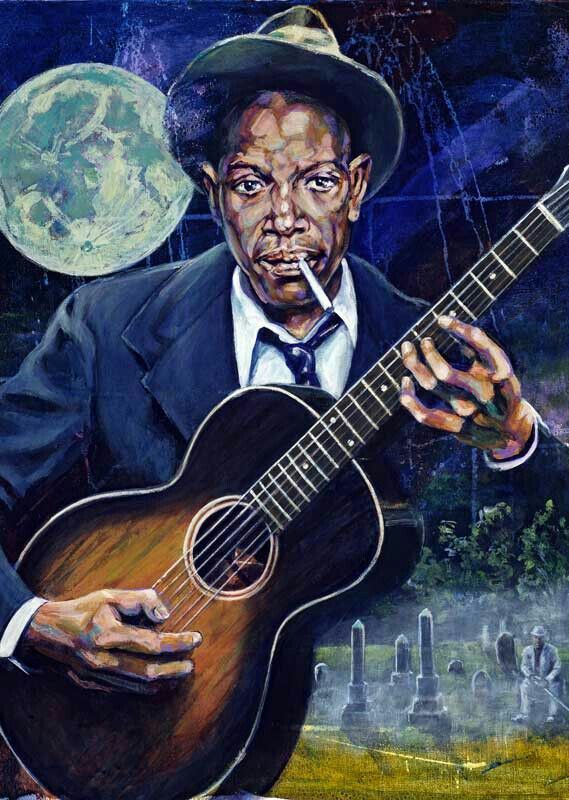
Early life
Robert Leroy Johnson was born in Hazlehurst, Mississippi, possibly on May 8, 1911, to Julia Ann Major Dodds (born October 1874) and Noah Johnson (born December 1884). Julia was married to Charles C. Dodds (born February 1865), a relatively prosperous landowner and furniture maker, with whom she had ten children. Charles Dodds had been forced by a lynch mob to leave Hazlehurst following a dispute with white landowners. Julia left Hazlehurst with baby Robert, but in less than two years she brought the boy to Memphis to live with her husband, who had changed his name to Charles Spencer. Robert spent the next 8–9 years growing up in Memphis and attending the Carnes Avenue Colored School where he received lessons in arithmetic, reading, language, music, geography, and physical exercise. It was in Memphis that he acquired his love for, and knowledge of, the Blues and popular music. His education and urban context placed him apart from most of his contemporary blues musicians.
Robert rejoined his mother around 1919–1920 after she married an illiterate sharecropper named Will "Dusty" Willis. They originally settled on a plantation in Lucas Township in Crittenden County, Arkansas, but soon moved across the Mississippi River to Commerce in the Mississippi Delta, near Tunica and Robinsonville. They lived on the Abbay & Leatherman Plantation. Julia's new husband was 24 years her junior. Robert was remembered by some residents as "Little Robert Dusty", but he was registered at Tunica's Indian Creek School as Robert Spencer. In the 1920 census, he is listed as Robert Spencer, living in Lucas, Arkansas, with Will and Julia Willis. Robert was at school in 1924 and 1927. The quality of his signature on his marriage certificate suggests that he was relatively well educated for a man of his background. A school friend, Willie Coffee, who was interviewed and filmed in later life, recalled that as a youth Robert was already noted for playing the harmonica and jaw harp. Coffee recalled that Robert was absent for long periods, which suggests that he may have been living and studying in Memphis.

Once Julia informed Robert about his biological father, Robert adopted the surname Johnson, using it on the certificate of his marriage to fourteen-year-old Virginia Travis in February 1929. She died in childbirth shortly after. Surviving relatives of Virginia told the blues researcher Robert "Mack" McCormick that this was a divine punishment for Robert's decision to sing secular songs, known as "selling your soul to the Devil". McCormick believed that Johnson himself accepted the phrase as a description of his resolve to abandon the settled life of a husband and farmer to become a full-time blues musician.
Around this time, the blues musician Son House moved to Robinsonville, where his musical partner Willie Brown lived. Late in life, House remembered Johnson as a "little boy" who was a competent harmonica player but an embarrassingly bad guitarist. Soon after, Robert Johnson left Robinsonville for the area around Martinsville, close to his birthplace, possibly searching for his natural father. Here he perfected the guitar style of House and learned other styles from Isaiah "Ike" Zimmerman. Zimmerman was rumored to have learned supernaturally to play guitar by visiting graveyards at midnight. When Johnson next appeared in Robinsonville, he seemed to have miraculously acquired a guitar technique. House was interviewed at a time when the legend of Johnson's pact with the devil was well known among blues researchers. He was asked whether he attributed Johnson's technique to this pact, and his equivocal answers have been taken as confirmation.
While living in Martinsville, Johnson fathered a child with Vergie Mae Smith. He married Caletta Craft in May 1931 in Copiah County, Mississippi. In 1932, the couple settled for a while in Clarksdale, Mississippi, in the Delta, but Johnson soon left for a career as a "walking" or itinerant musician, and Caletta died in early 1933.
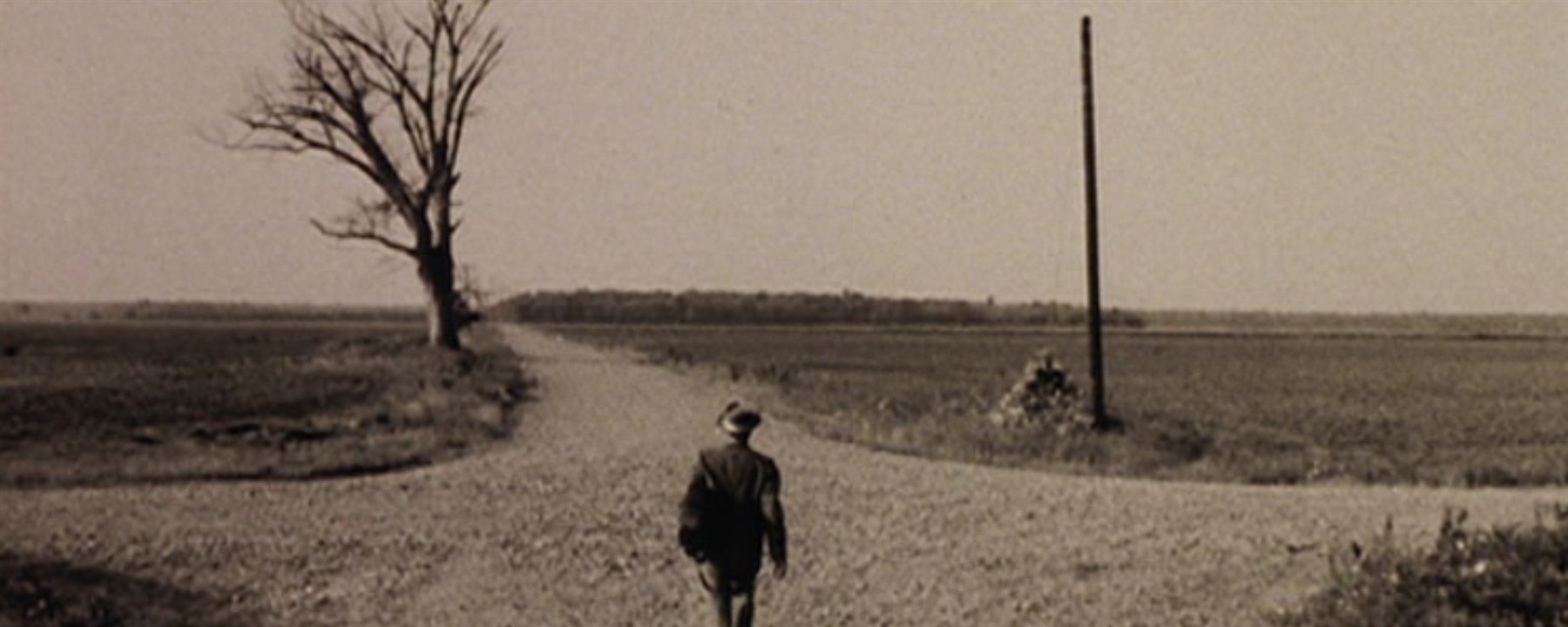
Itinerant musician
From 1932 until his death in 1938, Robert Johnson moved frequently between the cities of Memphis and Helena, and the smaller towns of the Mississippi Delta and neighboring regions of Mississippi and Arkansas. On occasion, he traveled much further. The blues musician Johnny Shines accompanied him to Chicago, Texas, New York, Canada, Kentucky, and Indiana. Henry Townsend shared a musical engagement with him in St. Louis. In many places he stayed with members of his large extended family or with female friends. He did not marry again but formed some long-term relationships with women to whom he would return periodically. In other places he stayed with whatever woman he was able to seduce at his performance. In each location, Robert Johnson's hosts were largely ignorant of his life elsewhere. He used different names in different places, employing at least eight distinct surnames.
Biographers have looked for consistency from musicians who knew Robert Johnson in different contexts: Shines, who traveled extensively with him; Robert Lockwood Jr., who knew him as his mother's partner; David "Honeyboy" Edwards, whose cousin Willie Mae Powell had a relationship with Robert Johnson. From a mass of partial, conflicting, and inconsistent eyewitness accounts, biographers have attempted to summarize Johnson's character. "He was well mannered, he was soft spoken, he was indecipherable". "As for his character, everyone seems to agree that, while he was pleasant and outgoing in public, in private he was reserved and liked to go his own way". "Musicians who knew Johnson testified that he was a nice guy and fairly average—except, of course, for his musical talent, his weakness for whiskey and women, and his commitment to the road."
When Robert Johnson arrived in a new town, he would play for tips on street corners or in front of the local barbershop or a restaurant. Musical associates have said that in live performances Johnson often did not focus on his dark and complex original compositions, but instead pleased audiences by performing more well-known pop standards of the day – and not necessarily blues.
With an ability to pick up tunes at first hearing, he had no trouble giving his audiences what they wanted, and certain of his contemporaries later remarked on his interest in jazz and country music. He also had an uncanny ability to establish a rapport with his audience; in every town in which he stopped, he would establish ties to the local community that would serve him well when he passed through again a month or a year later.
Shines was 20 when he met Johnson in 1936. He estimated Johnson was maybe a year older than himself (Johnson was actually four years older). Shines is quoted describing Johnson in Samuel Charters's Robert Johnson:
"Robert was a very friendly person, even though he was sulky at times, you know. And I hung around Robert for quite a while. One evening he disappeared. He was kind of a peculiar fellow. Robert'd be standing up playing some place, playing like nobody's business. At about that time it was a hustle with him as well as a pleasure.
And money'd be coming from all directions. But Robert'd just pick up and walk off and leave you standing there playing. And you wouldn't see Robert no more maybe in two or three weeks. ... So Robert and I, we began journeying off. I was just, matter of fact, tagging along."
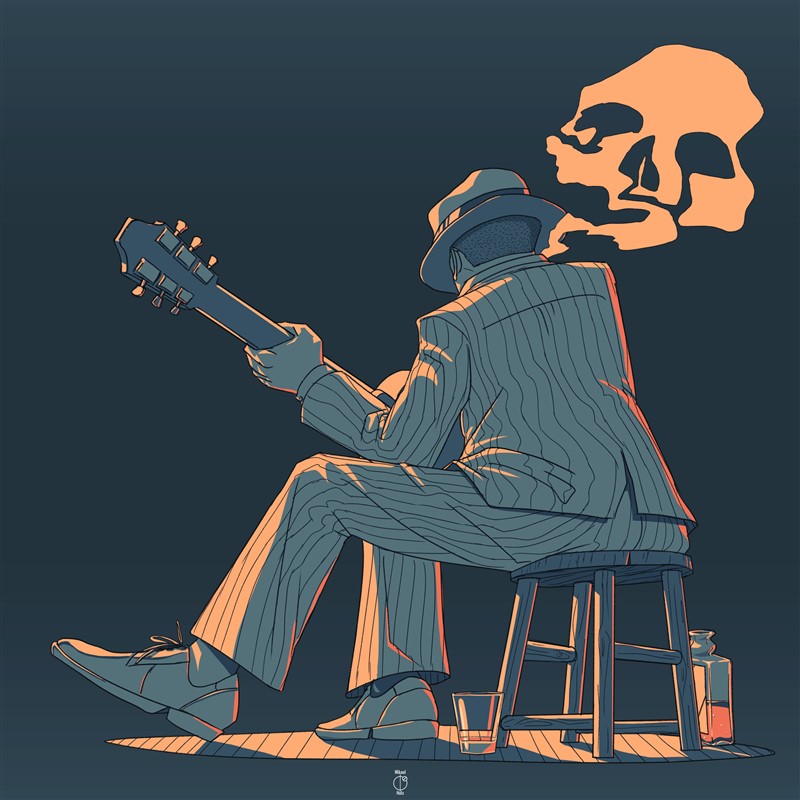
During this time Johnson established what would be a relatively long-term relationship with Estella Coleman, a woman about 15 years his senior and the mother of the blues musician Robert Lockwood Jr. Johnson reportedly cultivated a woman to look after him in each town he played in. He reputedly asked homely young women living in the country with their families whether he could go home with them, and in most cases, he was accepted, until a boyfriend arrived or Johnson was ready to move on.
In 1941, Alan Lomax learned from Muddy Waters that Johnson had performed in the area around Clarksdale, Mississippi. By 1959, the historian Samuel Charters could add only that Will Shade, of the Memphis Jug Band, remembered Johnson had once briefly played with him in West Memphis, Arkansas. In the last year of his life, Robert Johnson is believed to have traveled to St. Louis, Chicago, Detroit, and New York City. In 1938, Columbia Records producer John H. Hammond, who owned some of Johnson's records, directed record producer Don Law to seek out Johnson to book him for the first "From Spirituals to Swing" concert at Carnegie Hall in New York. On learning of Johnson's death, Hammond replaced him with Big Bill Broonzy, but he played two of Johnson's records from the stage.
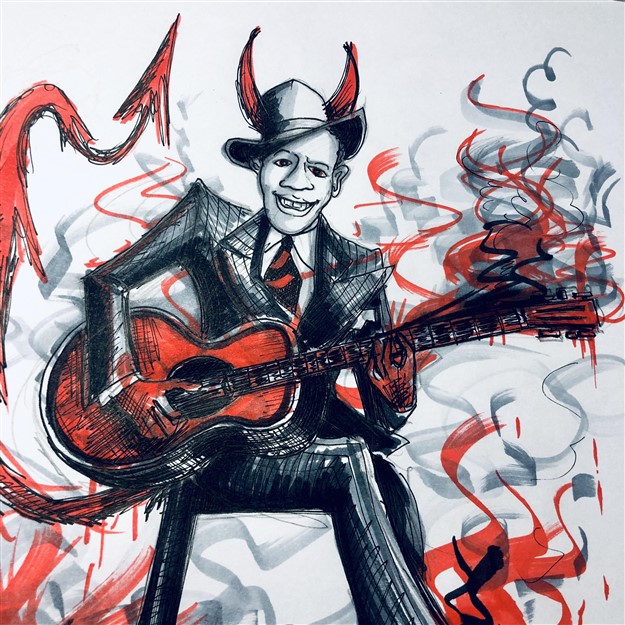
Recording sessions
In Jackson, Mississippi, around 1936, Johnson sought out H. C. Speir, who ran a general store and also acted as a talent scout. Speir put Johnson in touch with Ernie Oertle, who, as a salesman for the ARC group of labels, introduced Johnson to Don Law to record his first sessions in San Antonio, Texas. The recording session was held on November 23–25, 1936, in room 414 of the Gunter Hotel in San Antonio. In the ensuing three-day session, Johnson played 16 selections and recorded alternate takes for most of them.
Among the songs Robert Johnson recorded in San Antonio were "I Believe I'll Dust My Broom", "Sweet Home Chicago", and "Cross Road Blues", which later became blues standards. The first to be released was "Terraplane Blues", backed with "Last Fair Deal Gone Down", which sold as many as 10,000 copies. Robert Johnson traveled to Dallas, Texas, for another recording session with Don Law in a makeshift studio at the Vitagraph (Warner Bros.) Building, on June 19–20, 1937. Robert Johnson recorded almost half of the 29 songs that make up his entire discography in Dallas and eleven records from this session were released within the following year.
Most of Johnson's "somber and introspective" songs and performances come from his second recording session. Johnson did two takes of most of these songs, and recordings of those takes survived. Because of this, there is more opportunity to compare different performances of a single song by Johnson than for any other blues performer of his era. In contrast to most Delta players, Johnson had absorbed the idea of fitting a composed song into the three minutes of a 78-rpm side.
Death
Robert Johnson died on August 16, 1938, at the age of 27, near Greenwood, Mississippi, of unknown causes. Johnson's death was not reported publicly. Almost 30 years later, Gayle Dean Wardlow, a Mississippi-based musicologist researching Johnson's life, found Johnson's death certificate, which listed only the date and location, with no official cause of death. No formal autopsy had been done. Instead, a pro forma examination was done to file the death certificate, and no immediate cause of death was determined. It is likely he had congenital syphilis and it was suspected later by medical professionals that this may have been a contributing factor in his death. However, 30 years of local oral tradition had, like the rest of his life story, built a legend which has filled in gaps in the scant historical record.
Several differing accounts have described the events preceding his death. Johnson had been playing for a few weeks at a country dance in a town about 15 miles (24 km) from Greenwood. According to one theory, he was murdered by the jealous husband of a woman with whom he had flirted. In an account by the blues musician Sonny Boy Williamson, Johnson had been flirting with a married woman at a dance, and she gave him a bottle of whiskey poisoned by her husband. When Johnson took the bottle, Williamson knocked it out of his hand, admonishing him to never drink from a bottle that he had not personally seen opened. Johnson replied, "Don't ever knock a bottle out of my hand." Soon after, he was offered another (poisoned) bottle and accepted it. Johnson is reported to have begun feeling ill the evening after and had to be helped back to his room in the early morning hours. Over the next three days his condition steadily worsened. Witnesses reported that he died in a convulsive state of severe pain. The musicologist Robert "Mack" McCormick claimed to have tracked down the man who murdered Johnson and to have obtained a confession from him in a personal interview, but he declined to reveal the man's name.
While strychnine has been suggested as the poison that killed Johnson, at least one scholar has disputed the notion. Tom Graves, in his book Crossroads: The Life and Afterlife of Blues Legend Robert Johnson, relies on expert testimony from toxicologists to argue that strychnine has such a distinctive odor and taste that it cannot be disguised, even in strong liquor. Graves also claims that a significant amount of strychnine would have to be consumed in one sitting to be fatal, and that death from the poison would occur within hours, not days.
In their 2019 book Up Jumped the Devil, Bruce Conforth and Gayle Dean Wardlow suggest that the poison was naphthalene, from dissolved mothballs. This was "a common way of poisoning people in the rural South", but was rarely fatal. However, Johnson had been diagnosed with an ulcer and with esophageal varices, and the poison was sufficient to cause them to hemorrhage. He died after two days of severe abdominal pain, vomiting, and bleeding from the mouth.
The Leflore County registrar, Cornelia Jordan, years later and after conducting an investigation into Johnson's death for the state director of vital statistics, R. N. Whitfield, wrote a clarifying note on the back of Johnson's death certificate:
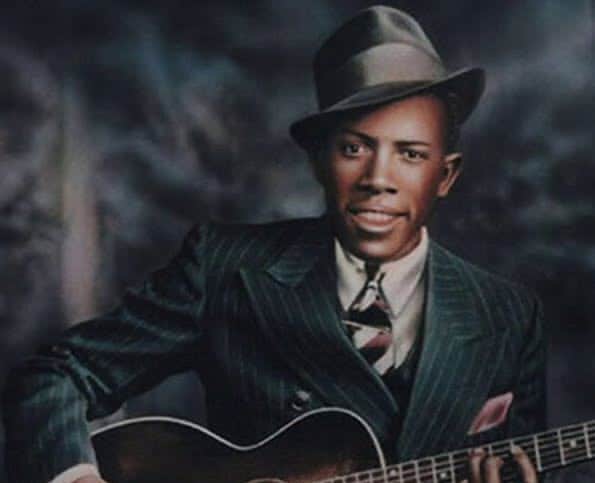
"I talked with the white man on whose place this negro died and I also talked with a negro woman on the place. The plantation owner said the negro man, seemingly about 26 years old, came from Tunica two or three weeks before he died to play banjo at a negro dance given there on the plantation. He stayed in the house with some of the negroes saying he wanted to pick cotton. The white man did not have a doctor for this negro as he had not worked for him. He was buried in a homemade coffin furnished by the county. The plantation owner said it was his opinion that the man died of syphilis."
In 2006, a medical practitioner, David Connell, suggested, on the basis of photographs showing Robert Johnson's "unnaturally long fingers" and "one bad eye", that Johnson may have had Marfan syndrome, which could have both affected his guitar playing and contributed to his death due to aortic dissection.

Gravesite
The exact location of Robert Johnson's grave is officially unknown; three different markers have been erected at possible sites in church cemeteries outside Greenwood.
Research in the 1980s and 1990s strongly suggests Robert Johnson was buried in the graveyard of the Mount Zion Missionary Baptist Church near Morgan City, Mississippi, not far from Greenwood, in an unmarked grave.
A one-ton cenotaph in the shape of an obelisk, listing all of Johnson's song titles, with a central inscription by Peter Guralnick, was placed at this location in 1990, paid for by Columbia Records and numerous smaller contributions made through the Mount Zion Memorial Fund.
In 1990, a small marker with the epitaph "Resting in the Blues" was placed in the cemetery of Payne Chapel, near Quito, Mississippi, by an Atlanta rock group named the Tombstones, after they saw a photograph in Living Blues magazine of an unmarked spot alleged by one of Johnson's ex-girlfriends to be Robert Johnson's burial site.
More recent research by Stephen LaVere (including statements from Rosie Eskridge, the wife of the supposed gravedigger, in 2000) indicates that the actual grave site is under a big pecan tree in the cemetery of the Little Zion Church, north of Greenwood along Money Road. Through LaVere, Sony Music placed a marker at this site, which bears LaVere's name as well as Robert Johnson's. Researchers Bruce Conforth and Gayle Dean Wardlow also concluded this was Johnson's resting place in their 2019 biography.
John Hammond Jr., in the documentary The Search for Robert Johnson (1991), suggests that owing to poverty and lack of transportation Robert Johnson is most likely to have been buried in a pauper's grave (or "potter's field") very near where he died.
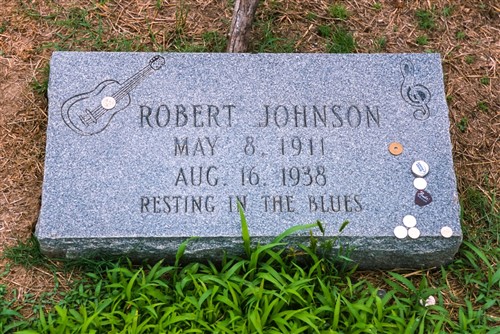
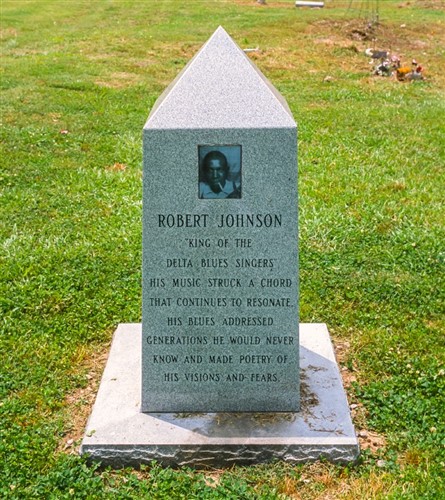
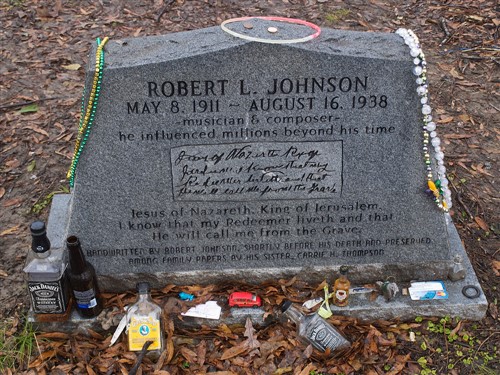
Devil legend
According to legend, as a young man living on a plantation in rural Mississippi, Robert Johnson had a tremendous desire to become a great blues musician. One of the legends often told says that he was instructed to take his guitar to a crossroad near Dockery Plantation at midnight. (There are claims for other sites as the location of the crossroads.) There he was met by a large black man (the Devil) who took the guitar and tuned it. The Devil played a few songs and then returned the guitar to Robert Johnson, giving him mastery of the instrument. This story of a deal with the Devil at the crossroads mirrors the legend of Faust. In exchange for his soul, Johnson was able to create the blues for which he became famous.
This story was originally associated with Delta blues musician Tommy Johnson, to whom Robert Johnson was unrelated. Tommy Johnson, who grew up near the Dockery Plantation and learned the blues from Charlie Patton and Willie Brown, first claimed to have sold his soul to the devil at a crossroads in exchange for his mastery of the guitar.
Various accounts
This legend was developed over time and has been chronicled by Gayle Dean Wardlow, Edward Komara and Elijah Wald, who sees the legend as largely dating from Johnson's rediscovery by white fans more than two decades after his death. Son House once told the story to Pete Welding as an explanation of Johnson's astonishingly rapid mastery of the guitar. Other interviewers failed to elicit any confirmation from Son House and there were fully two years between House's observation of Johnson as first a novice and then a master.
Further details were absorbed from the imaginative retellings by Greil Marcus and Robert Palmer. Most significantly, the detail was added that Johnson received his gift from a large black man at a crossroads. There is dispute as to how and when the crossroads detail was attached to the Robert Johnson story. All the published evidence, including a full chapter on the subject in the biography Crossroads, (Crossroads: The Life and Afterlife of Blues Legend Robert Johnson, 2008. Marquette/DeMers Books, 2008. ISBN 978-1942531258) by Tom Graves, suggests an origin in the story of the blues musician Tommy Johnson.
This story was collected from his musical associate Ishman Bracey and his elder brother Ledell in the 1960s. One version of Ledell Johnson's account was published in David Evans's 1971 biography of Tommy Johnson, and was repeated in print in 1982 alongside House's story in the widely read Searching for Robert Johnson, by Peter Guralnick. In another version, Ledell placed the meeting not at a crossroads but in a graveyard. This resembles the story told to Steve LaVere that Ike (Isaiah) Zimmerman of Hazlehurst, Mississippi, learned to play the guitar at midnight while sitting on tombstones. Zimmerman is believed to have influenced the playing of the young Robert Johnson.

Recent research by the blues scholar Bruce Conforth, in Living Blues magazine, makes the story clearer. Robert Johnson and Ike Zimmerman did practice in a graveyard at night, because it was quiet and no one would disturb them, but it was not the Hazlehurst cemetery as had been believed: Zimmerman was not from Hazlehurst but nearby Beauregard, and he did not practice in one graveyard, but in several in the area. Johnson spent about a year living with and learning from Zimmerman, who ultimately accompanied Johnson back to the Delta to look after him.
While Dockery, Hazlehurst and Beauregard have each been claimed as the locations of the mythical crossroads, there are also tourist attractions claiming to be "The Crossroads" in both Clarksdale and Memphis. Residents of Rosedale, Mississippi, claim that Robert Johnson sold his soul to the devil at the intersection of Highways 1 and 8 in their town, while the 1986 movie Crossroads was filmed in Beulah, Mississippi. The blues historian Steve Cheseborough wrote that it may be impossible to discover the exact location of the mythical crossroads, because "Robert Johnson was a rambling guy".

Interpretations
Some scholars have argued that the devil in these songs may refer not only to the Christian figure of Satan but also to the trickster god of African origin, Legba, himself associated with crossroads.
Folklorist Harry M. Hyatt wrote that, during his research in the South from 1935 to 1939, when African-Americans born in the 19th or early 20th century said they or anyone else had "sold their soul to the devil at the crossroads", they had a different meaning in mind.
Hyatt claimed there was evidence indicating African religious retentions surrounding Legba and the making of a "deal" (not selling the soul in the same sense as in the Faustian tradition cited by Graves) with the so-called devil at the crossroads. The Blues and the Blues singer has really special powers over women, especially. It is said that the Blues singer could possess women and have any woman they wanted.
And so when Robert Johnson came back, having left his community as an apparently mediocre musician, with a clear genius in his guitar style and lyrics, people said he must have sold his soul to the devil. And that fits in with this old African association with the crossroads where you find wisdom: you go down to the crossroads to learn, and in his case to learn in a Faustian pact, with the devil.
You sell your soul to become the greatest musician in history. This view that the devil in Johnson's songs is derived from an African deity was disputed by the blues scholar David Evans in an essay published in 1999, "Demythologizing the Blues":
"There are ... several serious problems with this crossroads myth. The devil imagery found in the blues is thoroughly familiar from western folklore, and nowhere do blues singers ever mention Legba or any other African deity in their songs or other lore. The actual African music connected with cults of Legba and similar trickster deities sounds nothing like the blues, but rather features polyrhythmic percussion and choral call-and-response singing."
The musicologist Alan Lomax dismissed the myth, stating, "In fact, every blues fiddler, banjo picker, harp blower, piano strummer and guitar framer was, in the opinion of both himself and his peers, a child of the Devil, a consequence of the black view of the European dance embrace as sinful in the extreme".
Both Lomax's and Evans's accounts themselves have been disputed and dismissed by Black scholars and authors including Amiri Baraka and Cornel West. West defines Blues as a creation of a people "who are willing to look unflinchingly at catastrophic conditions", as children of God responding to those conditions. Baraka's words are more directly critical of white writers who study African-American Blues artform and culture from a Western viewpoint, stating that "They have to do that to make themselves superior in some kind of way: that everything has come from Europe, which is not true". Baraka cites that rather than being formed out of any Western context, Blues derives from an African context of its own. The call-and-response singing Lomax argues is different from Blues has been widely cited as being a central aspect of Blues music.
Musical style
Johnson is considered a master of the blues, particularly of the Delta blues style. Keith Richards, of the Rolling Stones, said in 1990, "You want to know how good the blues can get? Well, this is it". But according to Elijah Wald, in his book Escaping the Delta, Johnson in his own time was most respected for his ability to play in a wide range of styles,
from raw Country slide guitar to jazz and pop licks, and for his ability to pick up guitar parts almost instantly upon hearing a song. His first recorded song, "Kind Hearted Woman Blues", in contrast to the prevailing Delta style of the time, more resembled the style of Chicago or St. Louis, with "a full-fledged, abundantly varied musical arrangement". The song was part of a cycle of spin-offs and response songs that began with Leroy Carr's "Mean Mistreater Mama" (1934). According to Wald, it was "the most musically complex in the cycle" and stood apart from most rural blues as a thoroughly composed lyric,
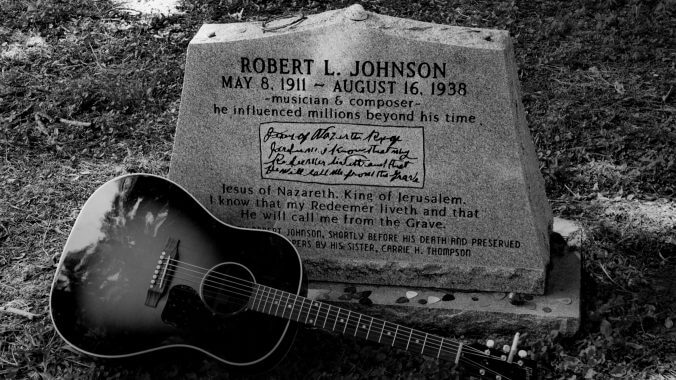
rather than an arbitrary collection of more or less unrelated verses. Unusual for a Delta player of the time, a recording exhibits what Johnson could do entirely outside of a blues style. "They're Red Hot", from his first recording session, shows that he was also comfortable with an "uptown" swing or ragtime sound similar to that of the Harlem Hamfats, but as Wald remarked, "no record company was heading to Mississippi in search of a down-home Ink Spots ... [H]e could undoubtedly have come up with a lot more songs in this style if the producers had wanted them."

Gibson L-1 Robert Johnson
Source: Wikipedia

